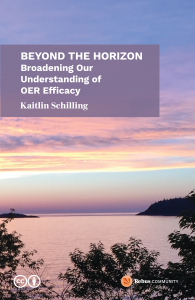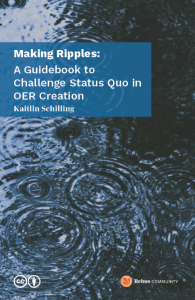A Note on the Cover

Beyond the Horizon: Broadening the Impact of Open Educational Resources (OER) attempts to capture the idea of exploring the expanded potential and influence of OER. It suggests a focus on how OER can reach beyond traditional boundaries and make a significant impact in education. Presently, the majority of materials published around OER efficacy are either scholarly journals, research articles, or geared towards institutions and administrators. This practical guidebook zooms into how creators can be mindful of OER efficacy throughout the creation process, as well as how to measure impact.

The rationale behind the cover choices for Rebus’ guidebooks is to symbolically represent the core themes and concepts discussed within each publication. The front cover image in Figure 1 features a photograph I took just outside of Wawa, Ontario, Canada. It is a west-facing image of Lake Superior during sunrise. The sky has purple, pink, yellow, and blue hues that reflect onto the open water. In the foreground of the image are shore-lined trees that surround the Great Lake.
In the case of the Rebus Guide to Publishing Open Textbooks (So Far), Figure 2, the image of a tree-lined road is chosen. Just as trees provide a stable and grounded environment, the guide aims to offer a reliable and comprehensive resource for individuals involved in open textbook publishing. The tree-lined road symbolizes the journey and progression towards open textbook creation, emphasizing the importance of a strong foundation.
On the other hand, the cover of Making Ripples: A Guidebook to Challenge Status Quo in OER Creation, Figure 3, features an image of a puddle with ripples caused by the rain. The purpose of this choice is to capture the fluidity and impact of water. Water, in this context, represents life and the transformative power of Open Educational Resources (OER). The image suggests that by challenging the status quo in OER creation, one can create ripples of change that have a far-reaching impact. Additionally, the metaphor of a puddle signifies the potential for growth and expansion, indicating that small actions can lead to significant effects.

The reference to the horizon here further reinforces the symbolic interpretation. The horizon represents the line separating the Earth from the sky, where the known and unknown meet. There are multiple types of horizons. A true horizon is one where it’s completely flat – you can see everything, and that’s usually attached to water. So when you think about the water in the series of Guides being representative of equity, if you have an equity lens, you have a clearer visual of the horizon. By looking at the impact of OER through a DEI (Diversity, Equity, and Inclusion) lens, one can gain a clearer picture of the horizon. This perspective suggests that considering DEI in measuring the impact of OER allows for a broader and more comprehensive understanding of its effects. The analogy of beaches as the best vantage points for viewing the unobstructed horizon illustrates that by looking at the impact of OER through a DEI lens, one can have a more complete and unbiased assessment.
In summary, the cover choices and the associated rationale aim to visually represent the fundamental concepts and themes of each guidebook. The tree-lined road signifies a solid foundation for open textbook publishing, while the puddle and horizon symbolize the fluidity, transformative power, and broad perspective of OER creation when approached with an equity lens.
Media Attributions
- Beyond the Horizon Cover © Kaitlin Schilling is licensed under a CC BY (Attribution) license
- The Rebus Guide to Publishing Open Textbooks (So Far) Cover © Apurva Ashok is licensed under a CC BY (Attribution) license
- Making Ripples: A Guidebook to Challenge Status Quo in OER Creation Cover © Kaitlin Schilling is licensed under a CC BY (Attribution) license

